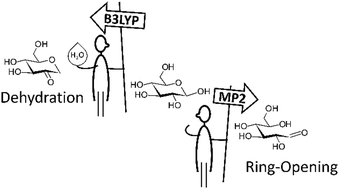Improved agreement between experimental and computational results for collision-induced dissociation mass spectrometry of cation-tagged hexoses†
Abstract
To model the collision-induced dissociation mass spectrometry (CID-MS) of Na+-tagged hexoses, it is not only required to perform an extensive sampling of the conformational space as addressed in our previous work [Huynh et al., Phys. Chem. Chem. Phys., 2018, 20(29), 19614–19624], it is also necessary to apply a sufficiently reliable quantum chemical method to describe the relative energetics of the reactions. In this work, the ring-opening via hemiacetal scission and the competing dehydration pathways have been re-evaluated at the MP2 level. The results show that previous studies at the B3LYP level display a systematic underestimation of the dehydration barriers by about 40 kJ mol−1 on average while the ring-opening barriers are reasonably described. We further illustrate that, in the present case, it is not enough to only look at the energetics: although MP2 results indicate that the ring-opening pathways of the considered hexoses have lower barriers than the dehydration pathways, the contributions of the partition functions to the rate constants render the dehydration for some structures to be more favorable at elevated temperatures. Via benchmark calculations against single-point CCSD(T) results at the example of small organic model molecules, we demonstrate that the MP2 data for the studied reactions are, alongside calculations at the M06-2X level, trustworthy. In addition, we have analyzed for the same set of model molecules how the fraction of exact exchange in the applied exchange–correlation functional affects the reaction barriers and the charge distributions. While MP2 (and M06-2X) calculations indicate an increased charge localization when going from the initial state to the dehydration transition state, this phenomenon is not seen in the B3LYP calculations, which likely is the origin of the discrepancy between the B3LYP and MP2 dehydration barriers. As the variation of the charge localization during a hemiacetal scission reaction is comparably small, B3LYP performs sufficiently well for such reactions.



 Please wait while we load your content...
Please wait while we load your content...